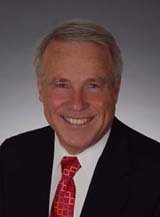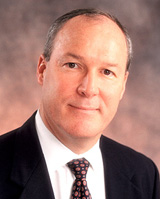|
By Jorge Casuso
August 15 -- One is
a relative newcomer who brings
plenty of experience working
for competing business districts,
the other is a longtime Santa
Monica resident and veteran
of the city’s political
wars.
New Chamber of Commerce President
and CEO Jim Lynch and the chamber’s
new board chair, attorney Tom
Larmore, hope to combine a fresh
take with plenty of institutional
memory to lead Santa Monica’s
business community during a
critical time for the city.
Larmore and Lynch took over
the top posts at a time when
businesses are continuing to
grapple with the longstanding
problems of homelessness and
parking. But it is also a time
to look into the future, as
business leaders help overhaul
Santa Monica’s General
Plan – which will dictate
the way the City will develop
– for the first time in
a quarter century.
 |
“There’s
tension in the city brought
out in the people who
view it as a suburb and
people who view it as
a city,” said Larmore,
who has lived in Santa
Monica since 1975. “That
seems to be the major
dividing line.”
Larmore, who moved near
Montana Avenue when it
was a sleepy stretch that
boasted half a dozen gas
stations and a plant nursery,
likes how Santa Monica
has grown into a vibrant
city and how the strip
near his home has turned
into a bustling row of
boutiques, restaurants
and coffee shops. |
“Some people like Montana
as it is today, and some people
don’t like it,”
Larmore said. “That’s
a city environment, that’s
not a suburban environment.
I think people enjoy that. They
like the activity and vitality.
Many people don’t realize
the services they get as a result
of the economy.”
Lynch, a former executive
with Schick Laboratories who
has headed chambers in several
Southern California cities,
sees Santa Monica’s economic
growth as both good and inevitable.
|
“As
the businesses rise, the
quality of life for everyone
rises,” said Lynch,
who grew up in Pasadena,
where his family owned
a pharmacy in nearby San
Marino.
Santa Monica’s
growth as a job center,
Lynch said, “would
have happened one way
or another, because we’re
part of a region that
is among the fastest growing
areas of the country.
"You can’t
just build a wall around
the city.”
|
 |
That employees will play a
key role in Santa Monica’s
emergence as a vibrant business
center that now claims nearly
as many jobs as there are residents
was the major theme hammered
home when the chamber installed
its new board of directors at
its annual dinner in June.
“The issues really revolve
around employees,” Larmore
said. “We’re going
to focus on increasing membership
and target large businesses
to make sure we have all of
the key players involved,”
he said, adding that Barnes
and Noble on the Third Street
Promenade recently joined the
chamber.
The key issues that impact
Santa Monica employees are workforce
housing, health care and education,
chamber officials said.
The chamber is currently involved
with a new task force recently
formed by the City to explore
ways to create affordable housing
for professionals who work in
Santa Monica, where housing
prices have skyrocketed and
an estimated 80 percent of the
workers live outside the city.
“That’s a big
deal for many of our members,”
Larmore said. “They have
a problem recruiting and maintaining
employees because of the cost
of housing.”
The chamber also is exploring
ways to provide health care
to its members. Although a plan
to have the chamber itself become
a group policyholder will likely
not work out, the chamber has
formed a healthcare subcommittee
to explore potential reforms.
“We want to understand
the healthcare proposals and
hope to become a small part
of the overall reform,”
Larmore said.
The chamber also is boosting
its education efforts, partnering
with the Santa Monica Malibu
Unified School District to help
students prepare for the job
market.
“We’ve had two
job fairs that not only resulted
in more jobs, but in students
preparing for those jobs,”
he said.
Larmore became a local political
player during the hotly contested
1981 City Council race that
saw Santa Monicans for Renters’
Rights – the tenants group
responsible for rent control
– wrest control of City
government from the business
community.
He later helped organize a
homeowners group that helped
turn out 3,000 people to a meeting
on the City’s housing
element and was a leading force
in the successful effort to
defeat the City’s unprecedented
living wage law at the polls
five years ago.
If Larmore brings a wealth
of experience in the local political
area, Lynch, who owned a computer
and accounting firm and was
publisher of the Westside Chronicle,
has long been a business leader.
Lynch has headed chambers
in Tustin, Los Angeles, Pasadena
and Beverly Hills, where he
launched the popular Westside
mixers that brought together
members from different area
chambers.
Lynch sees a bright future
for Santa Monica, where he believes
relations between the business
community and City officials
are improving. The government
and business sectors, for example,
are working together to tackle
the city’s long-entrenched
homeless problem.
“We’re working
together with different agencies
of the City to address the homeless
problem,” Lynch said.
“That’s a broader
regional problem that may start
growing even faster with rising
real estate prices in the county.
“Not much was done to
address it in an effective manner,”
he said. “Now the time
has come.”
As expected, Lynch is a big
booster of Santa Monica and
its vibrant business sector.
“Some of the businesses
that have ended up here offer
high-paying jobs, and they’re
clean,” Lynch said. “The
hope would be that some of the
residents would be employed
here.
“Instead of (Santa Monica)
looking for the businesses, these
companies are finding us. More
businesses are wanting to locate
here.” |